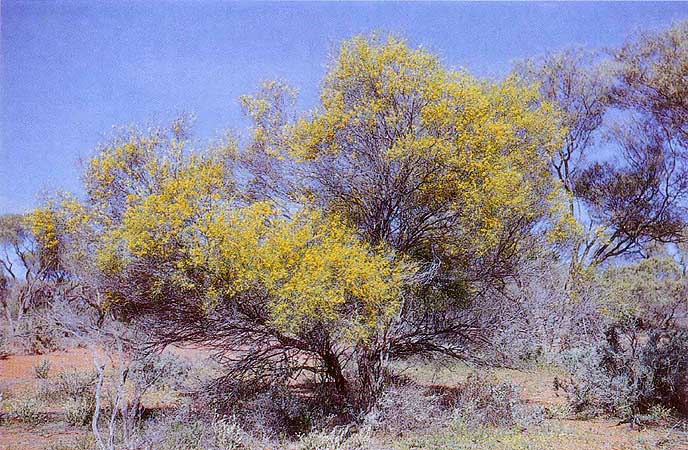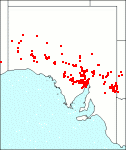Family: Fabaceae
Acacia burkittii

Citation:
G. Bentham, Fl. Aust. 2:400 (1864).
Derivation: burkittii—in honour of Samuel (?) Burkittt, a botanical collector, precise details not known.
Synonymy: A. randelliana W. V. Fitzg., J.W. Aust. Nat. Hist. Soc. 2(1):14 (1905).
, Acacia acuminata Common name: pin bush, Burkitt's wattle
Description:
Tall, glabrous shrubs 1-4 m high, dividing at ground level into a number of spreading-erect branches; branches almost terete, smooth, silvery- grey; bark dark brown and slightly fissured on main trunks.
Phyllodes linear, 6-16 cm long, c. 1 mm broad, subterete (i.e. slightly compressed) but somewhat flattened towards their apices, numerous fine longitudinal veins with the central vein often more prominent than the rest, characteristically ciliolate towards their finely curved non-pungent tip; glands basal, inconspicuous,
Inflorescences simple 2-3 per axil, sessile; spikes dense, 8-12 mm long, bright yellow; flowers 4-merous. Legumes moniliform, 6-12 cm long, 5-7 mm broad, slightly curved, brown. Seeds longitudinal in legume, obloid-ellipsoid; funicle with 2-3 folds below the aril.
|
|
Distribution:
|
The species occurs in the North-Western, Nullarbor, Gairdner-Torrens, Flinders Ranges, Eastern, Eyre Peninsula and Murray regions, in open shrubland to low open woodland. Soils; mainly shallow compact loam, brown calcareous earths and crusty alkaline neutral red duplex. Rainfall 150-300 mm. Also W.Aust. and western N.S.W.
S.Aust.: NW, NU, GT, FR, EA, EP, MU.
|
Flowering time: July — October.
|

SA Distribution Map based
on current data relating to
specimens held in the
State Herbarium of South Australia
|
Biology:
No text
Related taxa:
Acacia randelliana W. V. Fitzg. was described by Fitzgerald from material gathered at Kanowna and Mt Malcolm in Western Australia. This species was included by J. M. Black in Fl.S.Aust. 2:289 (1924) where it was distinguished from A. burkittii by minor legume and seed characters. However, from the material I have examined I am unable to distinguish between these two species and have therefore treated them as conspecific. B. R. Maslin, in a personal communication, considers A. randelliana to be conspecific with the 'narrow phyllode forms' of A. acuminata Benth. i.e. A, burkittii. Maslin considers there to be clinal variation from the relatively broad phylloded A. acuminata (endemic to W.Aust.) to the narrow, subterete A. burkittii (W.Aust., S.Aust.). Certainly further work is needed to clarify this situation.
Taxonomic notes:
The structure of an A. burkittii community under grazing was described by Crisp & Lange (1976). The site was Koonamore and the continuity of records there from 1928 enabled the age of the plants to be determined accurately. Mortality risk was very high for the first 8 years but was almost nil in the next 30 years. Vegetative reproduction from suckers does not occur. A relationship between stem girth and age was established and it was estimated that the maximum age for a plant was 250 years though the majority were of course far less than this. Estimates of the age structure of the shrubs outside the Reserve showed that very few new plants had become established since grazing began about 100 years earlier. Within the Reserve recruitment was also low apparently due to rabbit predation, but after 1974 when rabbits were again controlled, large numbers of seedlings were apparent. However the combined effect of sheep and rabbit grazing is to prevent completely the reproduction of A. burkittii in the area studied. The authors predict that within a century A. burkittii will be close to extinction where both rabbits and sheep occur together. Either, separately, will depress but probably not exterminate the species.
A. burkittii is illustrated in colour in Holliday (1976).
The distribution of A. burkittii in Australia was mapped by Hall et al. (1964). This species is common on sandhills in the Koonamore Reserve, occasionally forming thickets. Germination seems stimulated by fire and by summer rain. About half of the seedlings recorded have survived i.e. 7/18, but others died between 1-13 years old. They consider the species relatively unpalatable to sheep, rabbits and kangaroos.
Four mistletoes have been recorded on A. burkittii in South Australia. The most common has been Amyema preissii, wire-leaved mistletoe with many fewer A. quandang, grey mistletoe. Almost as common as the first is Lysiana exocarpi, harlequin mistletoe with a single collection of L. murrayi, mulga mistletoe.
Lange & Graham (1983) conducted experiments on the influence of rabbits on Acacia regeneration in the arid areas. A. burkittii was amongst the four species tested. Results showed that seedlings were severely pruned even with lowered post-myxomatosis rabbit population densities. Rabbit grazing pressure would significantly affect the recruitment in arid zone Acacia populations.
Cultivation:
This species likes a warm open position and is suitable as an ornamental in dry inland areas. Moderate to fast growth rate.
Author:
Not yet available
Source:

|

